- Offensive Techniques & Strategies
Mid Screen Offense
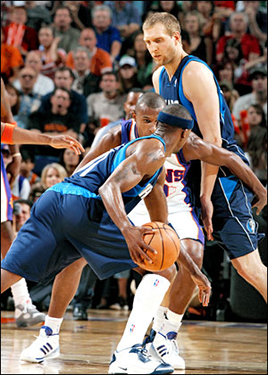
What to Discover or Recall . . .
The "Mid Screen" set offense is used by every NBA and WNBA team for very good reasons.
Since the action takes place in the center of the floor, with shooters spotting up on the wings, it takes away the helpside support making it very difficult to defend.
In addition, when executed, the on ball screen provides for an array of quick hitting options.
Mid Screen action can also be used very effectively as a final leg as the shot or game clock winds down.The Mid Screen Offense is the most used offense in the game today. It can be deployed as a set offensive play or as a final leg as the shot or game clock winds down. The basic option of the Mid Screen is for the point guard to drive hard off a high post screen. The high post player, usually a power forward or post, sets an "On Ball" screen to free up the point guard for dribble penetration. The point guard has the option of turning the corner for a drive to the basket or executing a pull up jumper if the defense goes below the screen. The point guard also has options of a drop pass to the post or kick out passes to the shooters spotting up on the wings.
| Basic Action | Reads & Counters | Ball Reversal | Variations | Installation | Game Strategy | Case for Defense |
Offensive Fundamentals Required
Schematic Sequence


Phase 1: Dribble Penetration
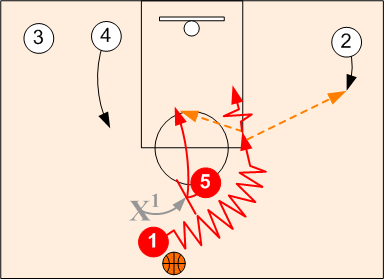
The basic action of the Mid Screen offense is for the point O1 to drive off a high post screen. The high post sets an On Ball screen to free up the point guard for dribble penetration. The dribbler has the options of:
Turning the corner for a drive to the basket.
Executing a pull up jumper if the defense goes below the screen.
Making a return pass to the post cutting away to the basket after the screen if the defense switches.
-
Making a kick out passes to the shooters spotting up on the wings.


Mid Screen Reads & Counters(Attacks)
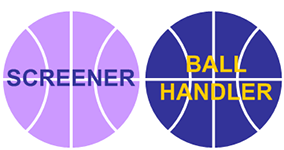
In basketball, it is the defense that dictates offensive options, not the offense. Therefore, the ability to read and counter defensive actions is paramount to any offensive success. In executing Mid Screens, it takes a coordinated effort by both the screener and ballhandler to counter the defensive actions being used against them. Therefore, players must possess a working knowledge and be prepared to recognize and attack the following situations:
Defensive Reads: What if the ....
Click on the desired read to view illustrated counter option
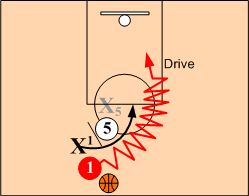

Read: Defensive players CHASES over the screen.
Counter: Point Drive
When defensive players X1 chases over the screen, O1 turns the corner on dribble and drives hard to the basket.
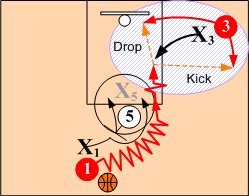
Read: Defensive player SAGS OFF shooter to help on drive.
Counter: Kick Out Pass
If a wing defender sags off to help out on O1's dribble penetration, O1 makes a kick out pass to O3 spotting up for open shot. O3 can also cut along the baseline for feed.
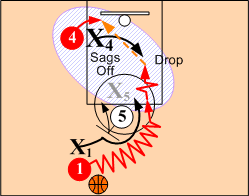
Read: Defensive low post player SAGS OFF to help on drive.
Counter: Post Drop
If baseline defender X4 drops off to help out on O1's dribble penetration, O1 makes a drop out pass to O4 for easy shot.
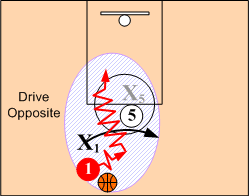

The ballhandler's defender anticipates screen and CHEATS OVER early.
Counter: Drive Opposite
The ballhandler drives opposite to the basket. In changing direction to drive opposite, the ball handler can use a front crossover, a reverse pivot (spin) dribble, a behind the back, or a reverse between the legs dribble.
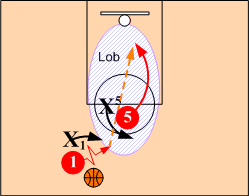
The screener's defender anticipates screen and OVER PLAYS to disrupt the screen.
Counter: Post Lob
When the screener's defender overplays to disrupt the mid screen action, the screener seals off the defender and releases for a lob or over the top pass.
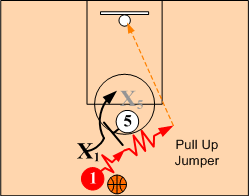

Read: Defensive players goes UNDER the screen.
Counter: Pull Up Jumper
When defensive player X1 goes under O5's screen, O1 pulls up for an open jump shot.
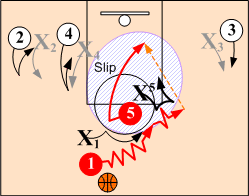

Read: Defensive players SHOW & RECOVER against the screen.
Counter: Show & Recover
When defensive players X1 and X5 try to show and recover against the screen, O1 strings out defender X5 with dribble. O5 rolls to basket looking for pass from O1. If defender X4 moves across to guard O5, then O5 pops and O4 cuts to the basket.
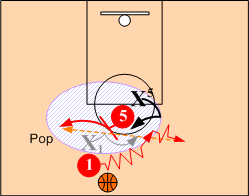
Post Pop Option
When screener O5 is a good outside shooter, O5 has the option of popping out against the show and recover defense instead of rolling to the basket. If O5 pops O4 goes opposite and dives to the basket. Defender X5 will have a hard time recovering against O5.
Note: If defender X5 is in foul trouble, O1 should drive hard to the basket looking to draw a foul.
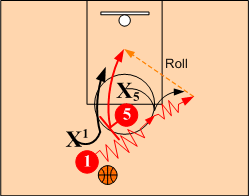

Defensive players SWITCH on the screen.
Counter: Post Roll
When defensive players X1 and X5 switch on screen, O1 looks to feed the screener O5 rolling to the basket or posting up against the smaller defensive guard.
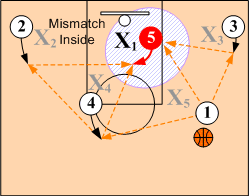
Smaller defensive player matched up inside against post.
Post Isolation
When O5 has a mismatch advantage against smaller defender O1, O5 posts up strong looking for a feed from any on the perimeter players.
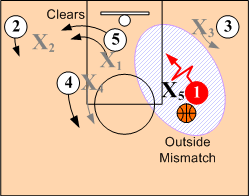
Big defensive player matched up outside against point guard.
Point Isolation
Against the defensive switch, when ball handler O1 has a definite advantage over bigger defender X5, screener O5 clears out allowing point to go one on one against X5. If/when point's shot is not available, post can then dive to the basket to exploit smaller X1.
Note: If the defensive wing should drop off to help, the point should make a kick out pass to wing spotting up for three point shot. If the baseline defensive player should step out to help, the point can make a drop pass into the low post.
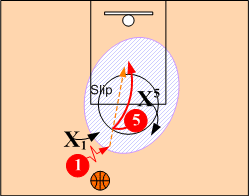
Defensive players ANTICIPATE switch and zone.
Counter: Post Slip
When defensive players X1 and X5 anticipate the switch and zone, high post should fake the screen and slip (cut away) to basket for shot.
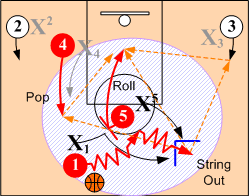

Read: Defensive players TRAP or DOUBLE TEAM on the screen.
Counter: String Out & Move the Ball
When defensive players X1 and X5 double teams O1 on screen, O1 should immediately string out (spread) the double team with dribble while 05 rolls to basket. O1 can pass directly to O5 or to any of the peripheral players for feed to O5. Ball must be moved in the air against the trap with sharp passes (no dribbling).
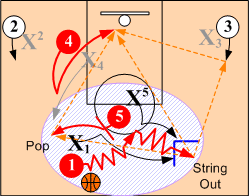
Post Pop Option
When defensive player X4 moves across to guard O5 on double team, O5 pops out and O4 cuts to basket. O1 can pass directly to O4 or to any of the peripheral players for feed to O4.

Phase 2: Ball Reversal
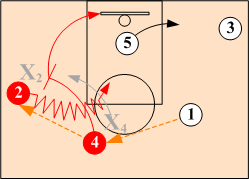
Although teams prefer to flow into a motion or passing game continuity, Mid Screen action can flow into almost any type of continuity. Click the View button to view some of the more common continuities.
Click on the desired continuity to view illustrated details
| Motion | Single/Double | Flex Continuity | Inside Triangle Game | Side Screen |
Power Passing Game (Motion)
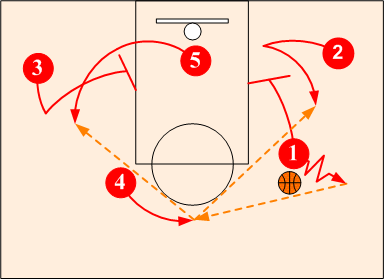
The Mid Screen action can flow directly into a motion or passing game continuity. The motion offense is initiated with O1 making a reversal pass out to O4 and setting a down screen along with O3. O4 looks to pass to O5 or O2 coming off the down screens or to O1 or O3 posting up inside.
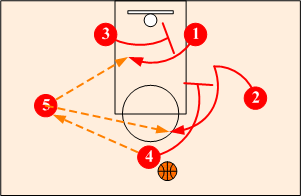
Screen Away. If O4 pass to O5 on wing, O4 and O3 screen away. O5 looks to feed O1 coming off O3's baseline screen or to O2 coming off O4's screen.
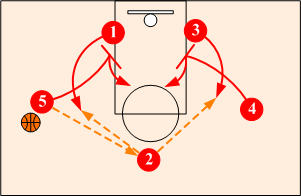
Down Screen. When the ball is passed out to the point the wings down screen.
Note: The baseline players also have the option of setting back screens for the wings.
Single/Double
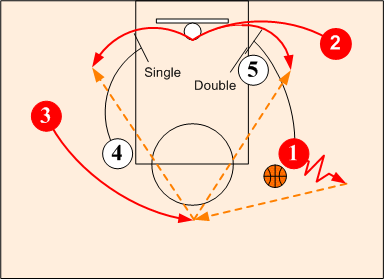
Single/Double. O1 makes a reversal pass out to O3 and sets a baseline double screen with O4 as shooter O2 cuts under the basket. O2 has the option of either continuing out off O5's single screen or doubling back off O1's and O4's double screen. O1 goes opposite of O4.
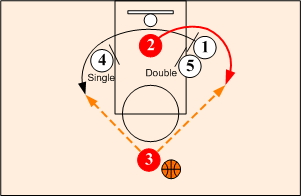
Double Screen Option. If O2 doubles back off the double screen, then O1 goes opposite off O4's base screen. O3 has options of passing to shooters O2 or O1 coming off base screens or feeding inside to O4 or O5 posting up.
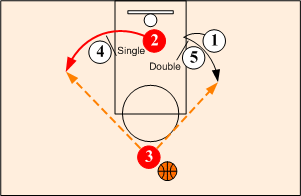
Single Screen Option. If O2 continues out off O4's screen, then O1 pops out same side off O5's screen.
Flex Continuity
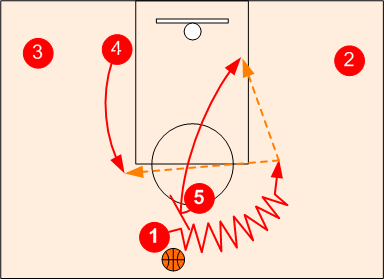
Phase 1. Point O1 drives off O5's mid screen. If the mid screen and roll action does not produce a good shot, then O1 makes a reversal pass out to O4 to initiate flex action.
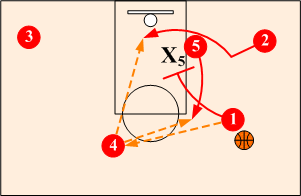
Phase 2. O2 rubs off O5's base screen and O1 sets a down screens for O5.
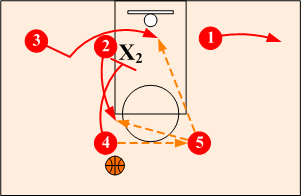
Phase 3. Continuity. O4 passes to O5 as O1 pops out to corner. O3 rubs off O32's base screen and O4 down screens for O2.
Inside Triangle Action
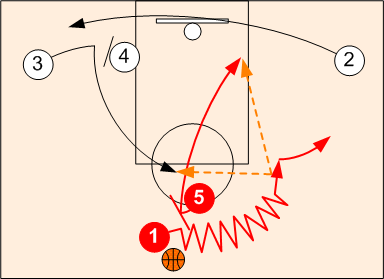
Phase 1. Shooter O2 clears to opposite wing as O1 and O4 execute a mid screen and roll. If the mid screen action does not produce a good shot, O1 looks to feed O3 popping out off O5's base screen to initiate triangle continuity.
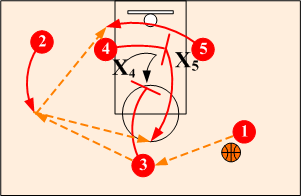
Down Screen Action
Ballhandler O1 makes a reversal pass out to O3 who in turns passes to O2. O1 can also make a skip pass directly across to O2. Post O4 sets a base screen for O5 and then pops out off O3's down screen. O2 looks to feed O5 or O4.
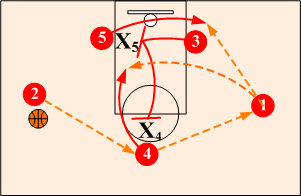
Back Screen Option
O2 makes a reversal pass to O4 who passes to O1. O2 can also make a direct cross court pass to O1. O3 sets a base cross screen for O5 and then back screens for O4. O1 looks to feed O5 or lob to O4.
Side Screen Continuity
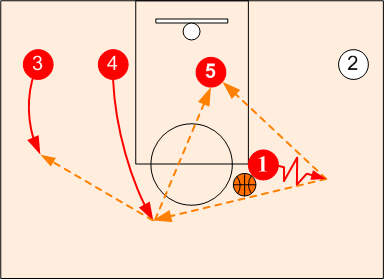
Post Isolation. When the screen and roll action does not produce a good shot, O1 or O4 looks to feed O5 in the low post area. When O1 makes a reversal pass out to O4 it initiates side screen action.
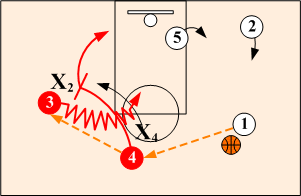
Side Screen. O4 passes to O2 on wing and sets an ON Ball screen. O2 drives over O4's screen initiating screen and roll action.
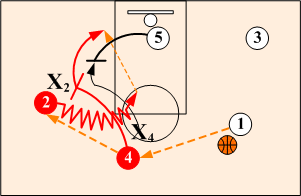
Back Screen (Boston). O5 sets a back screen for O4 rolling to basket. O1 and O3 spot up for three point shots.

Variations of Mid Screen
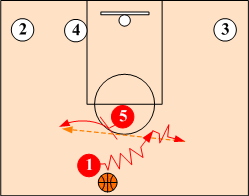
Various teams have adapted the mid screen action to take advantage of their specific player personnel. Most of these variations are actually secondary options off the high post screen action. Some of these more frequently used Mid Screen variations used include:
Click on the desired variation below to view illustrated details
| Post Pop | Horns | 1 - 4 Low | Post Isolation | Two Game |
Screen and Pop
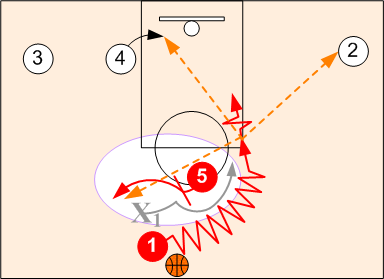
When the screener O5 or O4 is a good outside shooter, they have the option of popping out off the screen instead of rolling to the basket. The O4 reads the screener O5's action and goes opposite. When the screener O5 pops, O4 rolls to the basket.
Horns (Double Mid Screens)
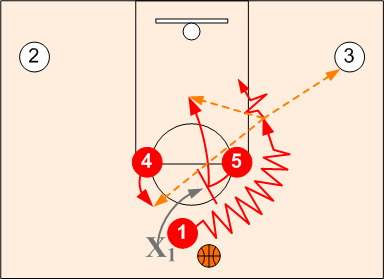
By deploying a second high post screener, it provides the ball handler the option of driving off a screen in either direction. Since mid Screens are available on both sides, the Horns alignment cannot be disrupted by simply influencing the ball handler away from the screen.
1 - 4 Low Alignment
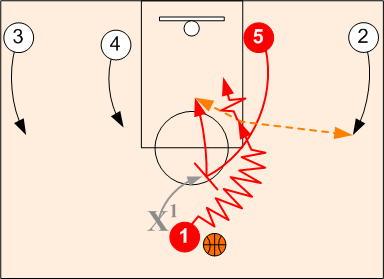
O2, O3, O4 and O5 set up on baseline isolating O1 one-on-one against X1. O5 or O4 breaks up an sets an On Ball screen for O1. O1 drives off O5's initiating Mid Screen action. Shooters O2 and O3 spot up on wings.
High Post Isolation
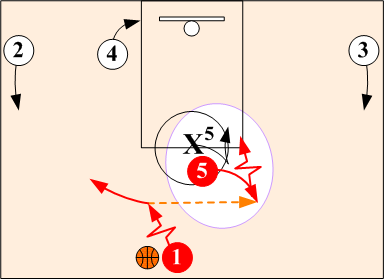
When defender X5 is mismatched against screener O5, O5 can pop out instead of setting a mid screen. Point O1 makes an entry pass to O5 and goes opposite creating a 1-on-1 isolation for O5. Shooters O2 and O3 spot up. Post Isolation can be ran to either the right or left side of the court.
Pass Entry (Two Game)
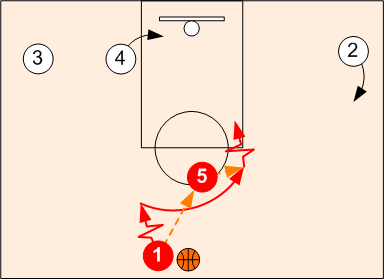
Ballhander O1 and Screen O5 have the option of initiating the "Two Game" at any time. O1 makes a high post entry pass and cuts off O5 for return feed. This "Two Game" provides a multitude of a quick hitting options.
 Triangle Post Weakside Two Game
Triangle Post Weakside Two Game

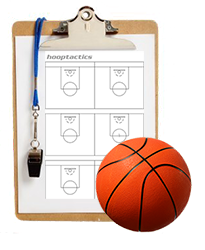
Teaching & Implementing the Mid Screen Offense
The key to the success of the Mid Screen Offense is in its execution and coordination. Players need to be well prepared to execute mid screens. The ballhandler and screener have to think and function as one unit. This requires proper defensive recognition, non-verbal communication, timing and experience.
Caution: Before undertaking any offense, players must have a solid, working knowledge of all of its components.
Mid Screen Breakdown Drills:
 Two Player Entries Drill (2-on-2)
Two Player Entries Drill (2-on-2)The Game Within a Game
Individual offensive skill development and improvement should be an integral part of every practice. In addition to early time (before practice) work, each player should, personally, have one or two individual fundamental techniques to work on during the course of a practice. The specific skill or skills will vary from player to player and can be assigned by the coaching staff or determined by the players themselves. As a reminder, the skill(s) should be written down on a 3 X 5 card and give it to each player prior to practice.

Game Strategies
Scout your opponent. Players need to know what reads to expect during the game. Opponents will generally use only a primary and secondary defense technique in defending side screens. Educate and explain the anticipated reads and their counters. When scouting is not possible, scout your opponent during the game.
Don't be a spectator and watch the ball during the game. Be conscience and alert to any defensive changes or adjustments, especially after substitutions and timeouts. Don't hesitate in deploying various alignments and entries during the game so that defenders cannot focus on defending just one set. Move players around and attack the weakest defenders.

The Case for the Defense
Even if you do not plan to use the Mid Screens, you better be prepared to defend against them. It is one of the most used offenses in the game.
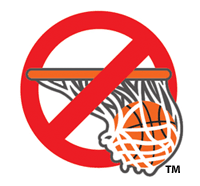
Continue and learn proven ways and techniques to disrupt Mid Screens
Return to Set Offenses - Click Here
Return to Offensive Strategies - Click Here
Return to HoopTactics - Click Here
© 2026 HoopTactics All Rights Reserved.
